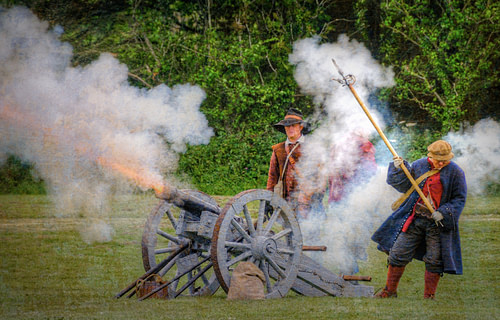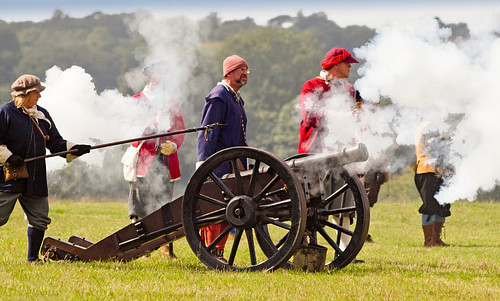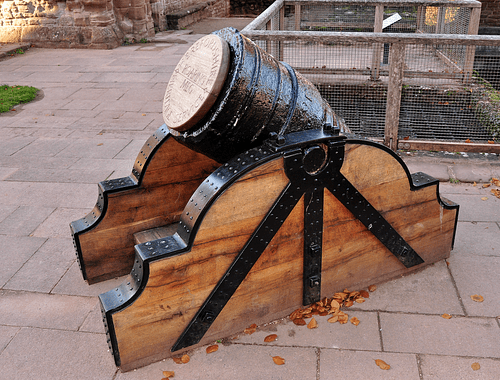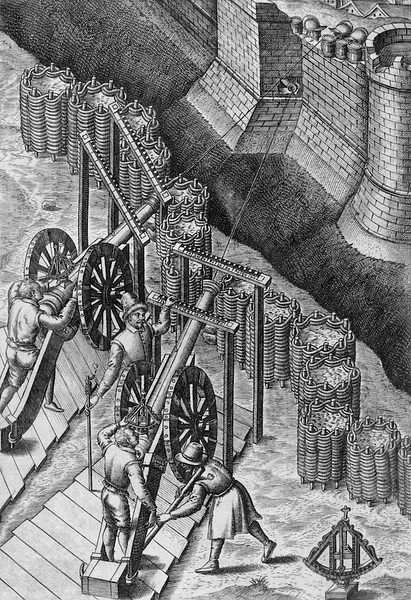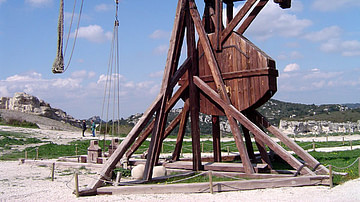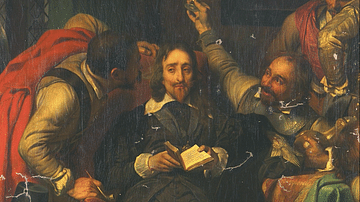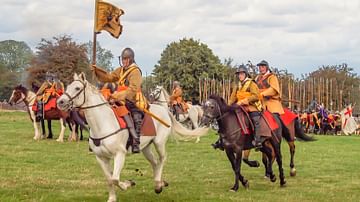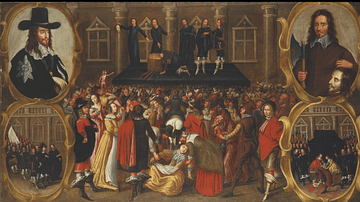During the English Civil Wars (1642-1651) artillery was an important if still developing feature of warfare. Both Royalist and Parliamentarian armies had large artillery units, which were used in battles and sieges throughout the conflict. With no particular standardisation, there were many different types of cannon and ammunition ranging from huge monsters that fired stone balls weighing 36 kg (80 lb) to handheld leather guns which fired grapeshot.
Civil War Artillery Units
Charles I of England (r. 1625-1649) considered himself an absolute monarch with absolute power and a divine right to rule, but his unwillingness to compromise with Parliament, particularly over money, led to a civil war from 1642 to 1651. Fought between the 'Roundheads' (Parliamentarians) and 'Cavaliers' (Royalists) in over 600 battles and sieges, the war was a bloody and protracted conflict.
Both armies had artillery units, but the number of cannons at any given battle or siege varied depending on availability, location, and the losses or captures of artillery in previous engagements. A general commanded an artillery train while groups of cannons – a battery – came under the command of a senior officer. Each individual gun team was led by the gunner who organised his various assistants. The Parliamentarian New Model Army began with 56 cannons, but the force expanded over time, especially with additions captured from the enemy. The Royalists, however, struggled to keep pace as the necessary finances became more difficult to raise as the war went in Parliament's favour.
The majority of guns in this period were cast in bronze or, less commonly, iron. Notable production centres were in the Tower of London, Frewin Hall at Charles' capital Oxford, and Horsmonden in Kent. Cannons were also pressed into service from naval ships, and many cannons were imported from Continental Europe, particularly the Netherlands. Portsmouth, Chatham, and Hull were all major arsenals. All were ports, a necessity as the largest cannons and large quantities of ammunition they needed were more easily transported by ship. Gunpowder was manufactured at specialist centres, often attached to the larger garrisons such as York and Newark on the Royalist side and many cities under Parliament's control. Gunpowder mills required charcoal, saltpetre, and sulphur to make gunpowder, with the latter two ingredients being particularly difficult to find.
Types of Cannons
Coming in all sizes and with a myriad of different names, cannons of the Civil War period can be broadly categorised into three groups: those large enough to damage fortifications and so used for sieges, those small and light enough to be moved around a battlefield, and those used when defending against a siege army. Within these three groups, there was no standardisation (even of terminology) since gun calibres were not standardised until 1716. Many 16th-century cannons were still in use, and imported cannons provided yet more variety. To add further confusion to the myriad of names, some cannons which had shorter barrels than was typical for their calibre and weight were called 'bastards', while 'drakes' were shorter and lighter versions of more standard types.
Cannons required two or three men to operate and at least six horses to move around the gun carriages. The largest cannons, which could weigh up to two and a quarter tons (5,000 lbs), were only used for sieges and needed a team of up to 20 horses to move around. One difficulty was the lack of good roads around the country, which meant that moving heavy artillery to besiege cities was a slow and costly operation wherever waterways were not available. A solution to the problem was to transport smaller cannons but then mount several of them together in what became known as 'cases' or 'frames', thus increasing their destructive power.
The larger cannons of the period, such as the cannon, demi-cannon, and culverin (longer and slimmer than a cannon), had a typical barrel length of up to 4 metres (13 ft) and could fire a solid ball of stone, lead, or iron up to 27 kg (60 lb) in weight. Most cannons (the demi-culverin, saker, falcon, and smaller culverin) fired a ball between 3 and 9 kg (7 to 20 lbs) in weight. There were some really massive guns in use, but their very size brought several practical problems, which illustrate that having a greater number of smaller cannons could be more effective.
The largest gun of all, the cannon royal, fired shot weighing 80 pounds [36 kg], but was rarely employed because of the enormous difficulties involved in transporting it, the huge amounts of gunpowder it consumed, and its very slow rate of fire, which sometimes made it possible for defenders to repair between shots some of the damage caused.
(Wanklyn, 4)
The limit of the effective range of most cannons was around 730 metres (800 yards), although half that was a more realistic expectation. Cannons, depending on size, could fire an impressive 10 to 15 times per hour, which, multiplied by the number of cannons in a battery, allowed for a continuous and harrowing bombardment of the enemy. Not for nothing were cannons given nicknames like 'Roaring Meg' or ironic monikers like 'Queen Elizabeth's Pocket Pistol' and 'Sweet Lips'.
Types of Ammunition
Besides solid stone and metal balls, there were mortars fired from short, wide cannons of that name. The shells the mortars fired were hollow metal balls filled with powder and set with a short fuse; they were designed to set the target aflame. Mortars fired their load over a very high trajectory, and so the fire-bomb could arc over defensive walls and fall into highly flammable thatch buildings deep inside a city.
Another type of bomb was called 'murthering shot', which was composed of metal containers packed with musket balls and odd pieces of metal which, when the bomb exploded on impact, sent shrapnel in all directions causing terrible injuries. A variation of this type of grapeshot was to have the pieces of metal in a canvas bag which was destroyed by the explosion of the powder and so sent the metal out over a wide arc. Even clay or glass containers might be used for a similar effect, although in that case, the powder charge was significantly reduced and so, too, the range of the shot. Finally, there was, in use towards the end of the war, a highly portable light artillery weapon made of a leather-encased metal tube, which could fire small charges of grapeshot at close range. The disadvantage of this weapon was that most versions could only be fired a limited number of times before the casing was damaged.
Firing a Cannon
The gun crew consisted of at least the following: a gunner who aimed the piece, the gunner's mate who loaded it, and an assistant. A specialist artillery engineer would have first calculated the correct range and trajectory using various instruments like scales, quadrants, and rulers to measure the angle of elevation of the barrel. His instruments would provide figures that could be compared to prepared charts, but really nothing replaced practical experience with a specific cannon.
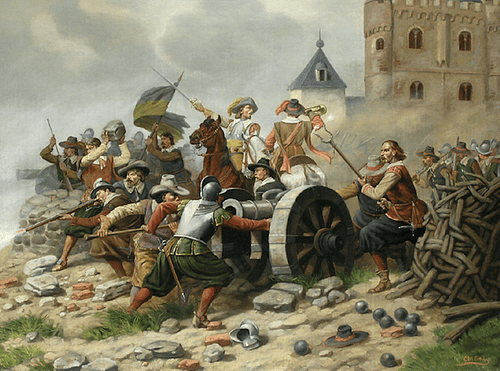
For each new shot (at least for larger cannons), the crew had to first cool down the barrel using a blanket of thin leather or sheepskin soaked in water. This was to ensure the new charge of powder did not prematurely explode. Another precaution between shots was to clear the barrel and touchhole of any blockages, residue spent powder or burning embers. When ready, the required measure of gunpowder was pushed down the barrel, blocked in place with wadding such as hay or oakum, and the cannonball gently pushed in. Another quantity of wadding was then added. A rod was next used to ram everything tightly to the bottom of the barrel. If the charge was not firmly packed then the explosive energy was lost, which reduced the range of the shot. A poorly packed charge could even blow up the cannon itself. The gunpowder was then lit through the touchhole in the top of the cannon using a slow match attached to the end of a long pole (linstock) for safety. The match lit fine-grained priming powder, which in turn set off the main powder charge.
With cannonballs that fitted a cannon well, the accuracy was high, but there were, unfortunately, many factors that could reduce this. A poorly cast cannon, imperfectly shaped balls, variations in the strength of powder, damp weather, and variations in wind strength could all conspire to make a shot ineffective. For this reason, cannons were fired in batteries so that several shots covered the same specific area of the target.
The view from the receiving end of cannon fire must have been impressive but terrifying. One Parliamentarian, Edward Robinson, at the siege of Lathom House in 1644-1645 noted the experience as follows:
Bullets made of free stone which weighed eight pound [3.6 kg] apiece they when shot forth would fly as high into the air that almost a man could not see them, and then the falling was so ponderous that they break down all where they lighted.
(Wanklyn, 89)
Tactics: Attack & Defence
Cannons and mortars were used in sieges and open battles. On the battlefield, both sides tended to indulge in an artillery barrage before the cavalry and infantry engaged. The barrage could be very short or last several hours. Cannons were placed either in front of the infantry units or behind them if there was a natural rise from which to fire over their heads. Parliamentary commanders, in particular, seemed reluctant to use artillery as the war went on because it did not remove the need for the infantry and cavalry to engage. It was sometimes felt that the trouble of dragging cannons around the countryside was not worth the results since, according to contemporary reports, they "caused more terror than execution" (Gaunt, 32).
Artillery might not have done much damage to an opposing army's overall numbers, but cannonballs, when fired on target, could be devastating in small pockets of action. One eyewitness at the First Battle of Newbury in September 1643, Captain John Gwyn, "saw a whole file of men, six deep, with their heads struck off with one cannon shot" (Henry, 37). There are other accounts of "legs and arms flying apace" (ibid) under an artillery barrage. It may be that commanders really used artillery to force an opposing infantry formation to move from a favourable position on the battlefield to a less favourable one.
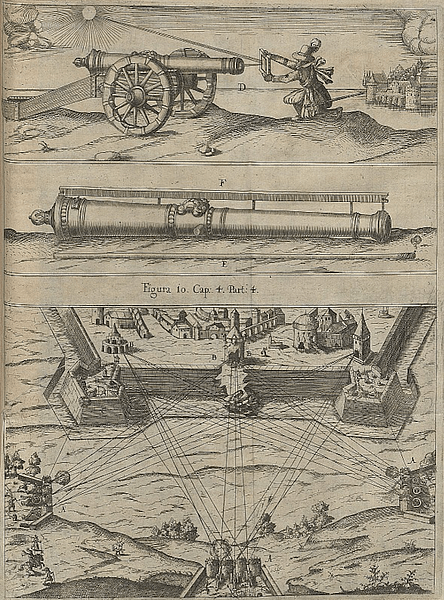
Whatever the strategic value of artillery, it certainly had an effect on morale, and the prestige of an army possessing cannons is illustrated by the eagerness of commanders to capture those of the enemy. For this reason, artillery and its lightly armed operators were protected by companies of musketeers armed with the latest flintlock weapons to avoid using the older slow-burning matches that could set off the nearby gunpowder.
Artillery was also used by both the attackers and defenders during sieges. For example, at the siege of Bristol in 1645, the city boasted 151 cannons spread along its various forts and fortification walls. The advantage of getting large cannons to a siege was that in the mid-17th century, city fortifications were still mostly from the medieval period and so could not stand up to a prolonged barrage, although modern earthworks helped protect some city walls and much depended on the type of stone which had been used. Those cities which had improved their defences with modern additions now had much lower but thicker walls that better withstood artillery and which provided a platform for cannons to be placed on. Newer fortifications also incorporated gunports to allow the defender's artillery to fire upon the enemy from any point.
Some cities now relied on an idea imported from Continental Europe: purpose-built forts which were connected to each other by a series of walls. The forts of the 17th century were specifically designed to resist artillery. The latest designs included sharp-angled bastions that could deflect cannonballs and permit defensive cannons to create a deadly crossfire on an approaching force. Cannons for defence were also placed in doorways, key passageways, and the main streets within a city. These lone cannons were filled with 'murthering shot' and, as they were typically cannons that could no longer be relied upon for regular barrages, were designed to be fired just once to cut down a large number of an attacking force that had infiltrated the main defences.
Meanwhile, the artillery of the besiegers (or of the field armies) was set on wooden carriages which were typically painted grey and reinforced with iron. The two-wheeled gun carriage was placed on strong wooden flooring such as oak planking so that they did not sink into the mud with every new blast. Sometimes a wicker platform was used for the same purpose and to better absorb the gun's recoil. Mortars did not have wheeled carriages.
Artillery pieces might be positioned within earthworks for protection which were either ditches with raised sides or a series of wicker baskets or interwoven saplings filled with earth (gabions) and placed around the battery. Another form of protection, at least against musket fire, was to have packs of wool arranged in front of the cannons.
The aim of the besiegers was to first assemble such an array of cannons and men that the city surrendered without resistance, but failing that, a section of the fortifications was bombarded to create an opening that the infantry could exploit. Ideally, shots from several cannons were aimed at the same spot at the base of a wall since, weakened at its foundation, the entire structure might then collapse. Wooden gates were another obvious target. Depending on the type of stone the target area was built of, such a bombardment could range from several hours to several days. Any more time than that was detrimental to the attackers, given the cost of getting the artillery in place in the first place, the consumption of gunpowder, and the general cost of keeping an army standing about. There was, too, the very real risk of disease greatly reducing an army in the field for any length of time. It was for this reason that if a city or castle did surrender, the terms were quite generous such as allowing the defending army to retreat elsewhere.
